Ad Hoc Introduction
This article gives details on how to set up and use Solver’s Ad Hoc Reporting feature in the Cloud portal. Ad Hoc Reporting is a user-friendly tool that provides a controlled grid for users to drag and drop fields from their Data Warehouse or supported ERPs, enabling quick data analysis. Ad Hoc Reporting is convenient for users who need to quickly analyze data without having to go through a detailed report creation process.
Ad Hoc offers the following, highlighted features:
- Convenient drag and drop functionality to create “reports”
- Grouping and sorting functionality
- Filtering capabilities
- Export to Excel functionality
- Data formatting including
- Currency Symbols
- Number of decimal places
- Number of rows
- Auto-refresh capabilities when making changes to reports
- Pivot (transpose) the data
Ad Hoc Reporting is included as part of your Solver purchase. Reference our Administration material for details on how to assign a user to the Ad Hoc application
Security, as configured in the Administration screens, is inherited ensuring users see only the data you have been assigned.
Menu and Interface
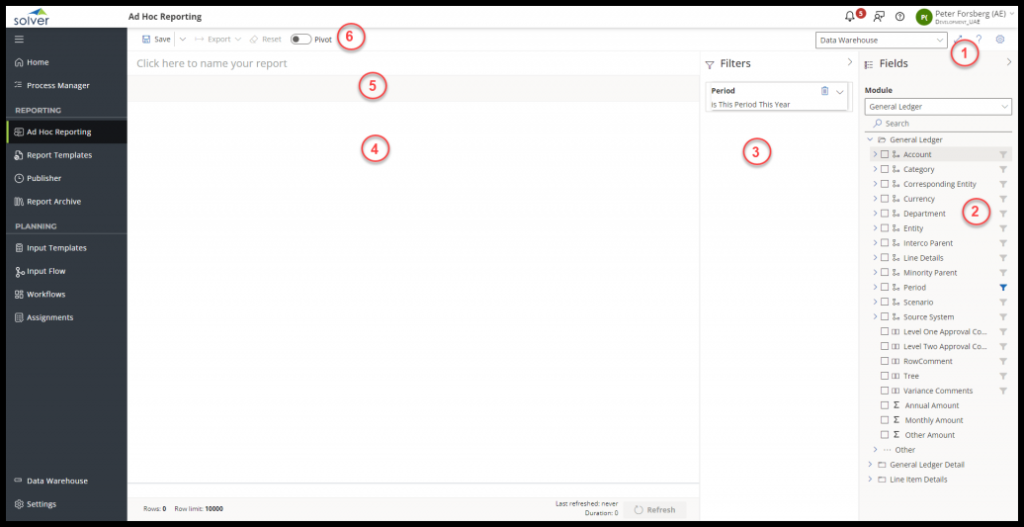
| Number | Feature | Description |
| 1 | Options: Gear Icon Help Icon Full-Screen Icon | Click the gear icon to view Ad Hoc settings. This includes the number of rows being displayed in the Ad Hoc report and when to refresh the screen. Keep in mind that the more data you bring into your Ad Hoc report, you may need to adjust these settings for an optimal user experience. Help Icon: click this icon to be taken through a quick application walk thru Full Screen: click this icon to enter full-screen mode. |
| 2 | Options: Module Selector Fields and Filters | For organizations with more than just the General Ledger, click the dropdown arrow to switch to a different module Choose the fields that should appear as columns in your Ad Hoc report by selecting the checkbox icon. Choose the filters of the report by selecting the filter icon. Filters can be defined in the filter grid (3) |
| 3 | Filter Grid | A list of all fields that have been selected as a filter. By default, for the Period dimension, this year this period is selected. Click this text to display a selector to choose different period options For dimensions, by default, all dimension codes will come in. Click the text to display a selector to choose specific dimension values. |
| 4 | Data Grid | Upon Clicking Refresh (bottom corner of the data grid), your Ad Hoc report will process, and once complete, data will appear in this grid. Click a column header to sort. To sort on multiple columns, use the [Ctrl] key and click the additional column to sort on. |
| 5 | Groupings | Drag column headers from your report into this section to create groupings of data. Typical use cases may include dragging Department into this section to group data by Department. |
| 6 | Actions: Create a Name for the Report Save Export Pivot | Should you want to save your Ad Hoc report for future use, type a descriptive name here in this box Save: click this button to save the report for future use Export: click this button to export the currently shown data to Excel Pivot: click this option to create a pivot view of your currently displayed data |
How to Use Ad Hoc for the First Time
After logging into Solver,
- Navigate to the Ad Hoc Reporting menu option
- For users using Ad Hoc for the first time or with no saved Ad Hoc reports, users are directed to the Get Started screen. Click on “Get Started” to begin.
- Users will have one of the following experiences based on their tenant configuration
- Tenants configured with a single connection to just the Data Warehouse, Ad Hoc will begin loading the interface. This may take a few seconds to load
- Tenants configured with multiple connections, one to the Data Warehouse and additional connections configured to their ERP via the Hybrid Agent, you will be prompted to select an integration and company

- Click OK
- If you have saved any Ad Hoc reports, upon clicking Ad Hoc Reporting, a listing of all previously saved reports will appear.
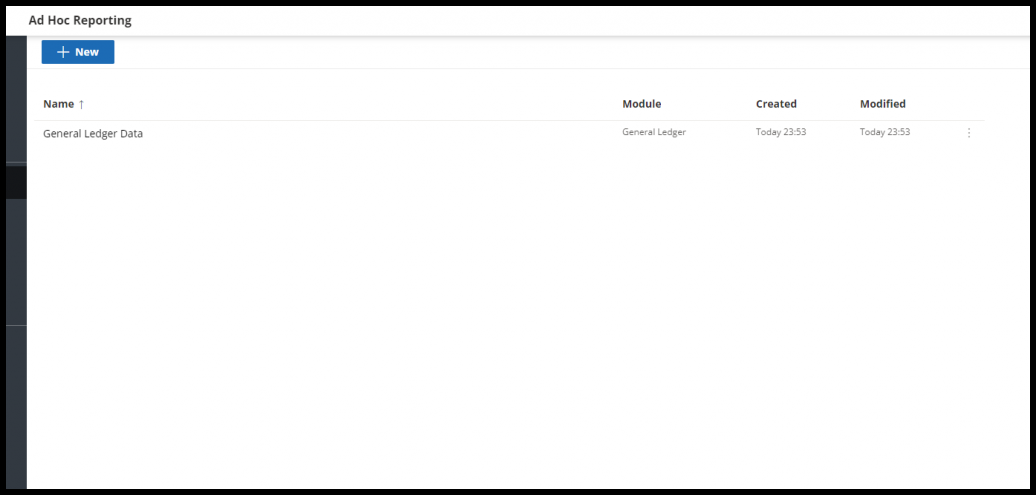
- The grid to the far right displays the factsets of the currently selected module.
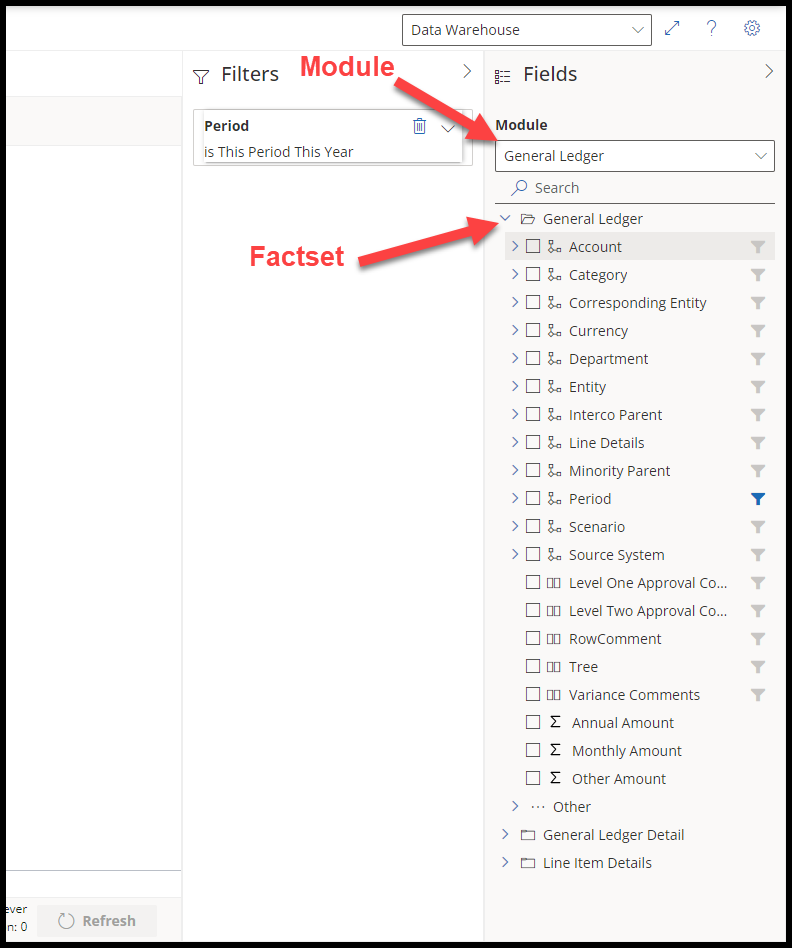
- The grid to the far right displays the factsets of the currently selected module.
- Period is a filter by default. Reference the blue filter icon. A default filter for “This period this year” has been applied and can be seen in the middle grid
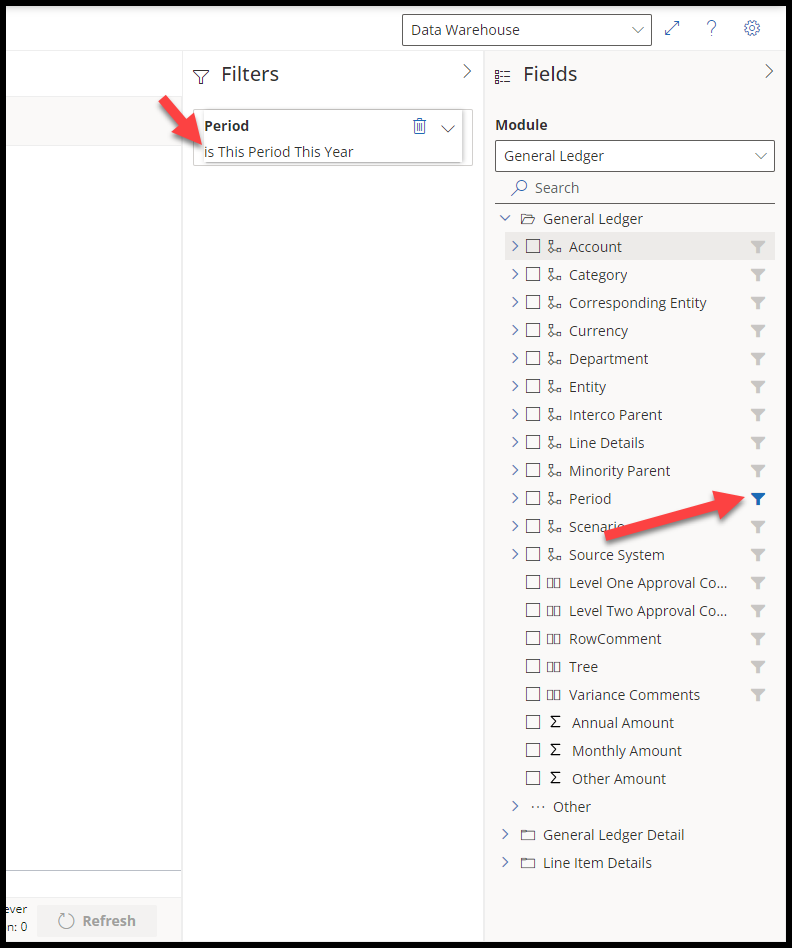
- Period is a filter by default. Reference the blue filter icon. A default filter for “This period this year” has been applied and can be seen in the middle grid
- Expand on the factset to display the dimensions you would like to bring into the report.
- Period is not a column that will appear in your Ad Hoc report because the checkbox is not selected. Check the checkbox to make Period appear in your report.
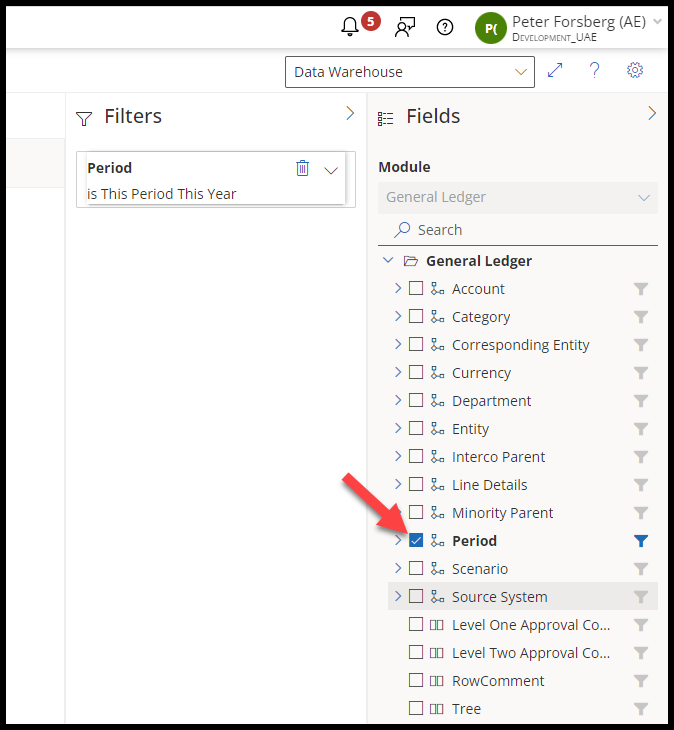
- Click the checkboxes for other dimensions and attributes you would like to see in your report. Click the filter icon to make it a value you can filter on.
- Once all fields are selected click Refresh in the bottom right-hand corner of the data grid.

- The refresh button becomes active (blue) based on a change being made to the selected fields and/or filters. If it is greyed out, there have been no changes made.
- If data does not load or is not what you are expecting, check your filters and make sure the correct filters are applied.
Click Save in the upper left hand corner and you have successful created your first Ad Hoc Report
Sharing an Ad Hoc Report
By default, an Ad Hoc Report is available to just the creator. Ad Hoc Reporting support sharing an Ad Hoc report with all other users of your tenant. To share an Ad Hoc Report.
- Navigate to Ad Hoc
- To the far right of the report you’d like to share, click the ellipsis and choose Share

Unsharing an Ad Hoc Report
The owner of an Ad Hoc report can choose to unshare their Ad Hoc Report.
- Navigate to Ad Hoc
- To the far right of the report you’d like to unshare, click the ellipsis and choose Unshare
Renaming an Ad Hoc Report
The owner of an Ad Hoc report can rename their Ad Hoc report. Upon changing the name, the new name will appear to all end users. To rename an Ad Hoc Report
- Navigate to Ad Hoc Reporting.
- To the far right of the report you’d like to rename, click the ellipsis and choose Rename.

- In the popup that appears, type in the new name and click Rename to save your work.
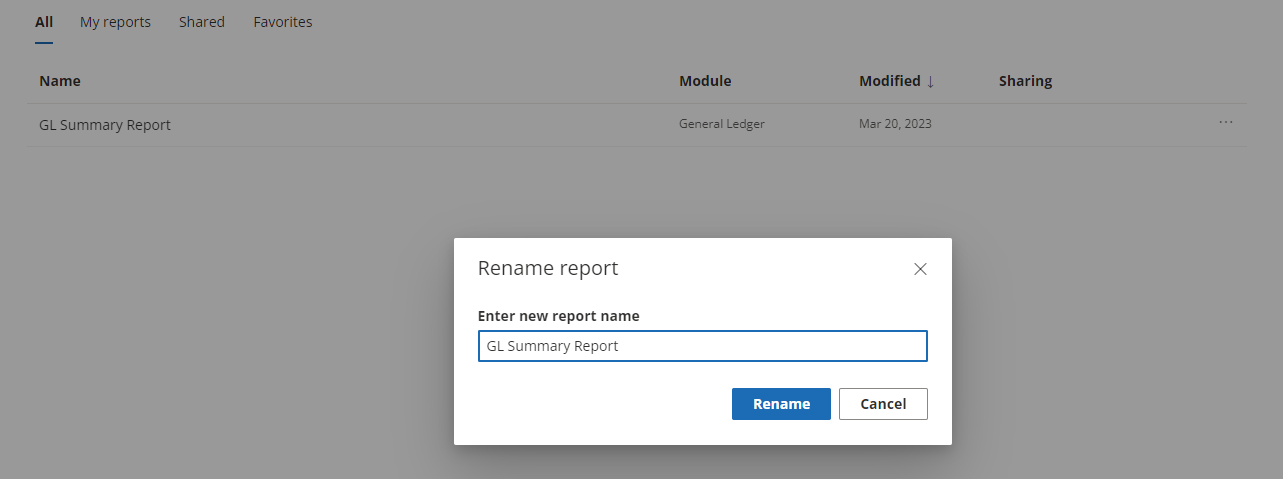
Deleting and Ad Hoc Report
Deleting an Ad Hoc report removes the report from the application. Additionally, if this report is shared amongst the users of the tenant, they will no longer see the report once deleted.
Deleting an Ad Hoc Report cannot be undone and the report cannot be recovered.
To delete an Ad Hoc Report
- Navigate to Ad Hoc Reporting.
- To the far right of the report you’d like to delete, click the ellipsis and choose Delete.

- A popup modal will appear confirming deletion and removal of this report from your tenant.

Ad Hoc Restrictions and Need to Knows
Ad Hoc Reporting has the following restrictions and limitations at this time
- Export and import Ad Hoc saved reports as a “template”.
- Export the Saved, Ad Hoc Report to be used as the start of a Report Designer template.
- A single Ad Hoc report can query only one module
- Filtering and module attributes can significantly increase the time it takes to render your report.